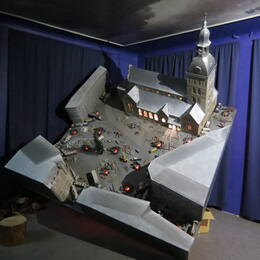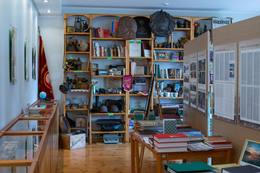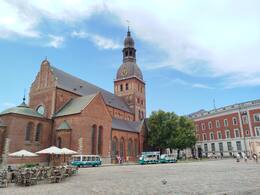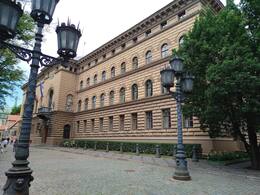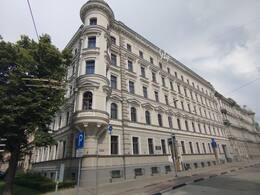Barricades
IV Soviet Occupation, Restored Independence
In January 1991, opponents of Latvia's independence attempted to stop the process of restoring independence and overthrow the legitimate government of the Republic of Latvia. To resist such aggressive action, barricades were erected around many strategically important buildings and a large number of residents were involved in patrols at them. Thanks to the broad involvement of the public, the attempt by opponents of independence to seize power failed. The barricades of January 1991 are an outstanding example of non-violent resistance of international importance.
Taking advantage of the political reforms implemented in the USSR in the second half of the 1980s, the society of the Baltic States clearly declared its desire to restore the independence of the Baltic States. In 1988, popular movements were established in the Baltic States (in Latvia, the Latvian People's Front or LTF), which soon announced that their main goal was to restore the independence of the Baltic States. In Latvia, the LTF won the elections held in March–April 1990, which allowed it to adopt the Declaration of Independence of May 4, 1990 with the support of more than two-thirds of the deputies. Despite the victory in the elections and the adoption of the declaration, the central government of the USSR did not recognize the Declaration of Independence, and on May 14, 1990, the President of the USSR M. Gorbachev signed a decree on the illegality of the Declarations of Independence of the Baltic States.
Despite M. Gorbachev's promises not to use violent methods to change power in the Baltics, Lithuania and Latvia, in January 1991, attacks by the USSR army and internal affairs bodies on local authorities and strategic objects took place. The aggravation of the situation in Latvia reached its highest point of escalation on January 14–20, when periodic attacks by fighters of the USSR special forces on Latvian authorities took place. Employees performing their official duties and civilians died in these attacks. The active involvement of society, blocking access to state administration institutions and strategic objects (barricades), thwarted the attempt to overthrow the legitimate government in the Republic of Latvia.
In the fight against the aggressors in January 1991, non-violent resistance methods were skillfully used. At the call of the government and the Latvian National Liberation Front, barricades were promptly set up around objects of national importance, guarded by unarmed civilians. Residents from all over Latvia participated in the creation of the barricades, representatives of rural regions arrived with heavy agricultural, logging, etc. equipment. On-duty participants were organized and, if necessary, regular replacement of participants was ensured. Volunteers delivered food, medical aid points were prepared, where medics were on duty. Approximately 40-50 thousand people directly participated in the barricades, and several hundred thousand residents indirectly participated in various rallies. Barricades were built at each object, guided by the real situation. When building the barricades around the Council of Ministers building, both heavy trucks, parked in a tight column, and timber were used.
Despite the fact that the Gulf War began in the Middle East during the barricades, the events in Riga resonated throughout the world. The Chairman of the Supreme Soviet of Russia, Boris Yeltsin, called on soldiers and officers not to participate in violent actions against the inhabitants of the Baltic republics. A rally was held in Moscow on January 20, at which about 100,000 people gathered to express their support for the Baltics. The USSR recognized the independence of the Baltic states only when it had already effectively collapsed after the August 1991 coup in Moscow. The 1991 barricades are one of the symbols of Latvia's restoration of independence. After the restoration of independence, large-scale commemorative events are held to commemorate the barricades. The barricades participants have been awarded commemorative signs. Since 2001, the 1991 Barricades Museum has been open at Krāmu Street 3 in Riga.
More information sources
www.mk.gov.lv/simtgade/On the way to the state of Latvia
100 events in Latvian history, people and processes 1918-2018. Latvian media
Related timeline
Related objects
Memorial stone commemorating the 1991 barricades
The first memorial in Latvia to commemorate the 1991 barricade period was made by Valmiera resident Jānis Sprudzāns in his granite products individual enterprise, the foundation was created by SIA “Grods”. The author of the idea for the memorial was Valmiera police major Aleksandrs Melngāršs (1954-2014), who led a group of Valmiera police officers during the January 1991 events in Riga. The sketches and design of the memorial sign were created by Dainis Saulītis. It was unveiled on January 24, 2002. Initially, the memorial sign was placed on the corner of Rīgas and Grants streets on private land, and later in 2010 it was moved to the Vidzeme Regional Administration building of the State Police opposite.
1991 Barricades Museum
The museum is located in Old Riga near the Riga Cathedral. It was founded in 2001 to preserve historical evidence of the events of 1991 in Latvia. A virtual tour of the museum is also available. In January 1991, in Lithuania the Soviet Army opened fire on people who had gathered at the Vilnius TV tower and drove into the crowd with tanks. In response to these events a demonstration of about 500,000 people was organised in Riga to show support to Lithuanians and the readiness of the Latvian people to continue their struggles towards Latvia’s independence. In order to prevent similar events from happening in Latvia, residents began to build barricades in the narrow streets of Old Riga in order to prevent possible attacks of the Soviet Army on the defenders of the barricades. These barricades were also created at various strategic objects not only in Riga, but throughout all of Latvia. Around 50,000 people from all over Latvia participated in defending the barricades. Barricades was a popular movement that helped to regain Latvia’s independence. This is a great example of non-violent resistance in the history of the whole world.
Vaidava Parish Local History Permanent Exhibition
Located in the Vaidava Culture and Crafts Center.
An exhibition dedicated to the memory of the deportations of 1949, as well as the participation of the Vajdavians in the barricades in Riga in January 1991, is on display. The exhibition also features evidence of the world wars (mainly printed materials).
Natural and historical objects, manors, history of education, culture, notable people, materials from the collective farm era, household utensils, banknotes, newspapers, magazines about Vaidava parish.
Dome Square in Old Riga
The importance of Dome Square during the Awakening was determined mainly by two circumstances – it was located in the immediate vicinity of the building of the Supreme Council of the Latvian SSR, as well as the fact that the building of Latvian Radio is located on the square. Various actions were held on Dome Square, putting forward demands to the Supreme Council, for example, on July 26, 1989, the Latvian Federation of Labor organized a rally attended by 60,000 people, demanding that the Supreme Council adopt the Declaration of Sovereignty. It was at this rally that the then popular slogan “Something in the past, but in free Latvia” was raised.
Dome Square was the main gathering place for the defenders of the barricades in January 1991, protecting the Supreme Council and the Radio House. The defenders of the barricades warmed themselves by the bonfires. They also stayed in the Radio House and the Dome Church. A first aid station was set up in the church, and services were held. In the evenings, popular rock bands performed on an improvised stage in the square. Every year, events commemorating the barricades are held in Dome Square.
Near the Dome Square, at Krāmu Street 3, there is a museum of the 1991 barricades. On January 13, 2018, the stained glass window “With passion for a free Latvia” by artists Krišs and Dzintars Zilgalvji was unveiled in the Dome Church - a dedication to the 1991 barricades and the independence of Latvia.
Parliament House (Saeima)
The former Vidzeme Knights' House has been the home of the Latvian Parliament since 1922. During the Soviet occupation, a pseudo-parliament - the Supreme Council of the Latvian SSR - was located here. In the elections to the Supreme Council held in March 1990, the main issue was the restoration of Latvia's state independence. This was done in accordance with the position of the Latvian Popular Front, which stated that it was more realistic to do this using the existing power structures of the USSR. In order to win a qualified vote in the Supreme Council, 134 votes were needed.
On May 4, 1990, the Supreme Council of the Latvian SSR adopted the Declaration “On the Restoration of the Independence of the Republic of Latvia”. 138 voted in favor of its adoption, 1 abstained, but 57 deputies who advocated Latvia remaining part of the USSR did not participate in the vote. By adopting the Declaration, the 1922 Constitution was restored in the territory of Latvia, but until the adoption of a new version of the Constitution, its operation was suspended, except for the first three articles of the Constitution. Such a transitional period was determined until the convocation of the Saeima of the Republic of Latvia. May 4 is celebrated as the Day of the Restoration of the Independence of the Republic of Latvia.
On May 15, 1990, opponents of independence attempted to seize the Supreme Council with the help of military cadets dressed in civilian clothes, but the spontaneously organized students of the Polytechnic Institute and the Institute of Physical Culture repelled the attack. The second attempt to attack the Supreme Council was stopped by the militia (the OMON unit, which in June 1990 refused to submit to the government of the Republic of Latvia and became the main strike force of the opponents of independence).
The Supreme Council was one of the most important points of barricade protection in January 1991. The approaches to it were fenced off with reinforced concrete blocks, and these protective structures were there until the unsuccessful coup attempt in Moscow on August 19-21, 1991. Soviet paratroopers and OMON fighters were unable to occupy the Supreme Council, and its deputies continued their work. On August 21, at 1:00 p.m., four OMON armored personnel carriers entered the Dome Square and remained there until 2:10 p.m., trying to intimidate the deputies, who at that time (at 1:10 p.m.) adopted the Constitutional Law on the State Status of the Republic of Latvia (111 deputies voted for, 13 against). This abolished the transitional period established on May 4, 1990 for the de facto restoration of state power in the Republic of Latvia, and Latvia regained full independence. In 2007, a memorial site for the January 1991 barricades was opened near the Saeima building on Jēkaba Street, and in 2000, in honor of the 30th anniversary of the restoration of the independence of the Republic of Latvia, a commemorative plaque was installed next to the main entrance of the Saeima with the inscription: "In this building, on May 4, 1990, the deputies of the Supreme Council adopted a declaration on the restoration of the independence of the Republic of Latvia."
Bastejkalns neighborhood in Riga
The area around Bastejkalns includes several memorial sites from the barricade era. The square, located at the intersection of Smilšu and Torņa streets, opposite the Powder Tower, was named the 1991 Barricade Square in 2016. The heavy equipment stationed here protected Old Riga from invasion at a strategically important location. The nearby Latvian War Museum housed barricade post no. 1.
On January 20, 1991, an OMON attack on the Ministry of Internal Affairs took place in the vicinity of Bastejkalns, which took the lives of several people. In the canalside greenery, opposite Bastejkalns, at the places where the victims were mortally wounded, memorials have been erected - stones to militia lieutenant Vladimir Gamanovič, inspector of the internal affairs department Sergejs Kononenko, director of the Riga Film Studio Andris Slapiņš, schoolboy Edijs Riekstiņš and the shot cameraman Gvido Zvaigznes, who died on February 5. There is a version that the shooters were not only and not so much OMON members, but also some “third force” - either from the special unit “Alfa”, or employees of the USSR State Security Committee from Moscow, who provoked the OMON attack on the Ministry of Internal Affairs.
A memorial stone has also been installed in the canalside gardens to the victim of August 19, 1991, Raimonds Salmiņš, who was shot by riot police near the Riga City Police Department building at the intersection of Aspazijas Boulevard and 13. janvāra Street. In 2014, a memorial plaque dedicated to the victims of the January 20, 1991 attack on the Ministry of the Interior was installed near the former Ministry of the Interior building at the corner of Raina Boulevard and Reimersa Street.
Freedom Monument in Riga
The Freedom Monument was one of the central symbolic points of the Awakening events. On June 14, 1987, the human rights group Helsinki-86 organized an unauthorized public flower-laying ceremony at the Freedom Monument. Two months later, on August 23, Helsinki-86 called for a rally at the Freedom Monument on the 48th anniversary of the Hitler-Stalin Pact of August 23, 1939. During this rally, Soviet police beat and arrested demonstrators. In the following years, flower-laying ceremonies at the Freedom Monument became a part of all major demonstrations and other mass events .
Located in the center of Riga, on Freedom Square.
The Freedom Monument is one of the most outstanding monuments of Latvian history, architecture and art. Built according to the project of Kārlis Zāle with public donations. It was unveiled in 1935 as a symbol of the Latvian people's freedom and love of their homeland. Together with the Riga Brothers' Cemetery ensemble, it belongs to the most valuable examples of monumental architecture and sculpture.
The Freedom Monument expresses the ethical and aesthetic values of Latvian culture. The symbols reflect the philosophical essence of freedom and the historical ideas of the Latvian nation about the stages of the struggle for independence. They point to the embodiment of physical and spiritual strength. The heroic language tells the story of the Latvian people as self-reliant, active creators of history and the determinants of their own destiny.
In its place, there was originally a monument to Russian Tsar Peter I. During World War I, it was dismantled to be transported by ship to Petrograd. The ship was torpedoed by a German submarine, and it sank off the Estonian island of Vormsi. The Soviet occupation regime planned to demolish the Freedom Monument several times, but this did not happen.
Today, you can see one of the symbols of Latvia and observe the traditions of the army honor guard.
A tactile Freedom Monument has been created on the canal bank, next to the Freedom Monument. This special bronze miniature was created by sculptor Ivars Miķelsons on a scale of 1:50.
Cabinet of Ministers building
In January 1991, one of the goals of the opponents of Latvian independence was to neutralize the government of the Republic of Latvia led by Ivars Godmanis, which was formed after the adoption of the Declaration of Independence on May 4, 1990. On January 9, 1991, pro-Moscow forces succeeded in achieving the resignation of the Kazimir Prunskiene government in Lithuania, mobilizing their supporters for protests against the increase in retail prices. On January 10, under the same pretext, a rally organized by Interfronte was held in front of the Council of Ministers. At it, about 10,000 participants demanded the resignation of the I. Godmanis government and tried to break into the building. The militia managed to prevent such attempts. The government and the Supreme Council demonstrated a united position, and the government did not resign.
After the tragic events in Vilnius on January 13, the Council of Ministers building was one of the first objects around which barricades were built, consisting of reinforced concrete blocks, logs, sandbags, and trucks and tractors. After the defeat of the 1991 coup, on the morning of August 25, the Lenin monument opposite the Council of Ministers of the Latvian SSR was dismantled.
Memorial site "Barricade"
The memorial site "Barricade" was established in Ulbroka, on the side of the Riga-Ērgļi highway near the bridge over the Piķurga River, where in January 1991 there were two barricade posts. One guarding the Riga border and the other guarding the Latvian Radio tower in Ulbroka. During the January events, radio was the main way to obtain information, so it was important not to allow radio communications to be interrupted. The 125-meter-high radio tower, which was used to broadcast Latvian Radio programs in the medium wave range, was guarded by both local residents of Ulbroka and neighbors from Garkalne, Ādaži, Tīnūži and Ropaži.
The text "Ulbroka.1991.I" is carved into two sides of the vertically placed stone block "Barricade", which was unveiled on November 11, 1991 and created by sculptor Uldis Sterģis. Every year on January 20, commemorative events dedicated to the January 1991 Barricades are held at this place. In 2003, 33 residents of Stopiņi parish were presented with a government award here - the Barricade Participant's Commemorative Medal. In 2024, the Ulbroka Library created a virtual exhibition "Barricades in Ulbroka. January 1991".
Related stories
Vaidavians on the barricades
In 2020, in anticipation of the 30th anniversary of the 1991 barricades, Vismants Priedīte shares the story of the participation of local residents in these historical events.
Memories of Kocēnietis Tālavs Megnis about the events at the 1991 barricades in Riga
Memories of Kocēnietis Tālavs Megnis about the events at the 1991 barricades in Riga.
"On January 13, about 40 Kocēni residents left the collective farm in an organized manner for a demonstration in Riga on the Laz bus, driven by Vitaly Sprukts, and the Latvija minibus, driven by Jānis Grava.
After the demonstration, when we met at the buses, we heard the Latvian People's Front's call on the radio several times for those who can to stay in Riga and defend strategically important objects to make their capture more difficult, similar to what happened at Vilnius Television. We saw these footage filmed by Podnieks before leaving for Riga.
From Rezekne to the barricades of 1991
The narrators describe the mood and personal experiences of the Barricades period. The memories well illustrate how information was able to reach the inhabitants of Latvia throughout its territory.




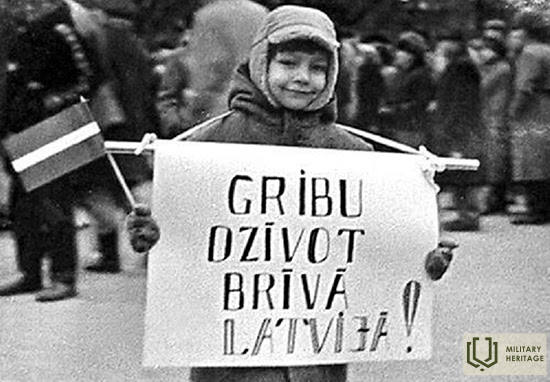
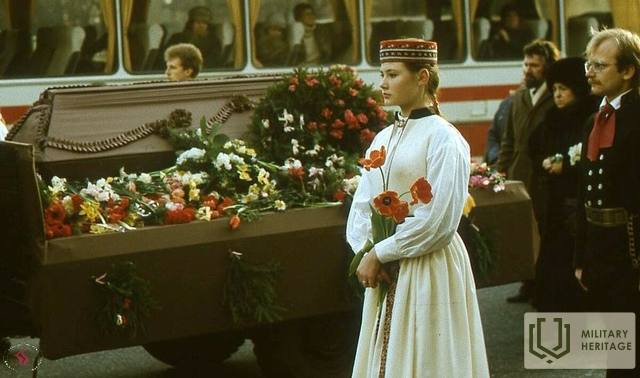
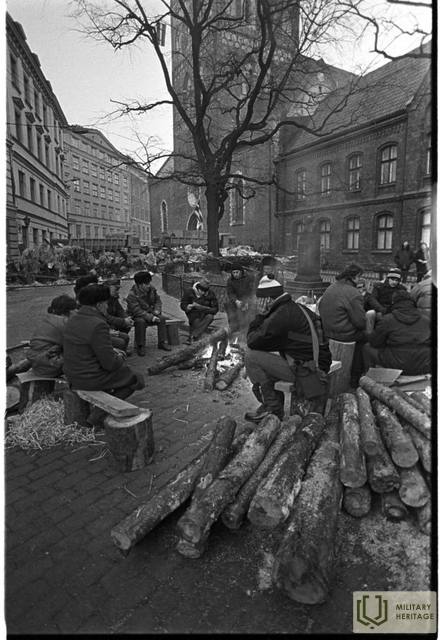
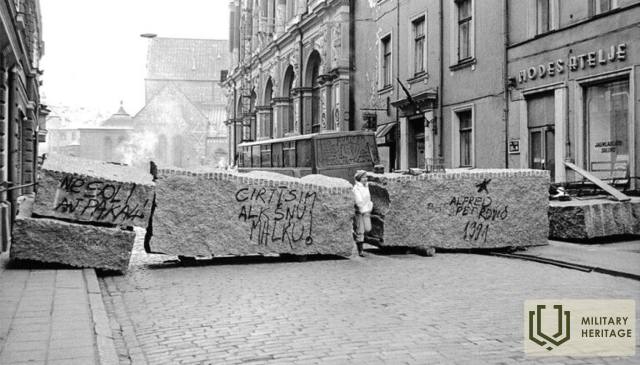
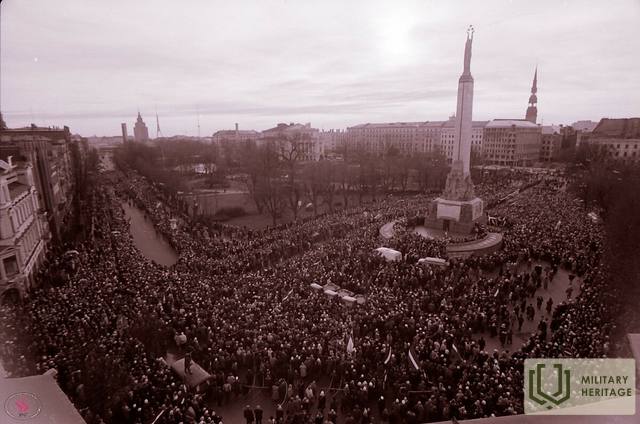


![A memorial stone commemorating the 1991 barricades on Rīgas Street in Valmiera. Source: Valmiera [illustrated edition], published by Jumava Publishing House, 2008. - p. 87. Author: Nils Smelteris.](/g/Poi/00540/Dzelzcela-tilts-Valmiera_1922g2.jpg?size=260)
